 |
 |
 |
| |
Evaluation of Resistance Patterns in Treatment-naive Subjects with Virologic Failure on Atazanavir- or Atazanavir/Ritonavir-containing Regimens
|
| |
| |
Reported by Jules Levin
XV Intl HIV Drug Resistance Workshop
June 13-17, 2006, Sitges, Spain
D McGrath, J Hammond, D Frederick, M Mathew, K Kastango, and C McLaren
Bristol-Myers Squibb Pharmaceutical Research Institute, Wallingford, CT, USA
Brief Summary:
The atazanavir (ATV) signature I50L substitution has been found in ATV resistant isolates from treatment-naive patients with virological failure on non-boosted ATV regimens, and has been associated with reduced in vitro susceptibility to ATV and increased susceptibility to other protease-inhibitors (PIs). We investigated the resistance profile of isolates from treatment-naive subjects with virological failure on boosted or non-boosted ATV regimens. Treatment-naive subjects (study AI424089) were randomized to ritonavir-boosted ATV (ATV300/RTV100) (n=95) or non-boosted ATV (ATV400) (n=105), each with lamivudine and stavudine (investigational extended-release formulation). Baseline and on-study isolates (HIV RNA ≥500 c/ml) from subjects experiencing virological failure (rebound or no response) were tested for geno- and phenotypic resistance. Phenotypic PI resistance or primary PI substitutions, including I50L, were not seen in the small number of subjects with virological failure on initial ATV300/RTV100 therapy. The ATV-signature I50L - or I50I/L - substitution was detected only in ATV400-subjects. The NRTI M184V substitution was found in the majority of on-study isolates from virological failures. The BMS study authors concluded: These findings confirm previous reports on the low incidence of phenotypic resistance to ATV in treatment-naive subjects treated with ATV, and suggest that co-administration of RTV may reduce the incidence of virologic failure and if virologic failure occurs, may limit the emergence of resistance mutations.
AUTHOR CONCLUSIONS
Virologic failure was low in both regimens; however, virologic failure was observed in fewer subjects on the ATV300/RTV than ATV400 regimen.
Fewer subjects on the ATV300/RTV regimen were observed to have viral rebound.
No treatment emergent PI substitutions, including I50L, were observed in subjects receiving ATV300/RTV100 therapy with virologic failure.
The ATV-signature I50L- or I50I/L-substitution was detected only in ATV400-subjects with virologic failure.
Phenotypic resistance (FC=26) was observed in on-study isolates from only 1 of 8 tested ATV400-treated subjects with virologic failure. This isolate had a fold change of 26 to ATV in association with an I50L substitution together with mixed populations at K20, L33 and A71 and demonstrated increased susceptibility to other PIs.
The other 7 ATV400-treated subjects with virologic failure maintained phenotypic susceptibility to the other PIs with a trend towards increased susceptibility in one subject with an I50I/L mixture.
The NRTI-M184V substitution (high-level resistance to 3TC) was found in the majority of on-study isolates from virologic failures, even in the absence of PI resistance.
DISCUSSION
Virologic failure was less frequent in subjects receiving a regimen containing ATV300/RTV than ATV400. Although genotype data were not available for all on-study failure isolates, differences in the resistance profiles were observed between the 2 arms. Whereas 4 of 8 genotyped isolates from subjects with ATV/400 had evidence of mutations that may contribute to PI resistance, neither of the 2 on-study isolates from ATV300/RTV-treated subjects had PI-related mutations. In addition, the I50L isolate was only observed in subjects receiving the ATV 400 mg regimen. The only isolate with phenotypic resistance to ATV (fold change = 26) was from an ATV400 subject. As previously observed in other isolates with the I50L mutation; this isolate had an increased susceptibility to other PIs; the effect of the other mixed mutations in that isolate (K20K/I/T, L33L/F and A71A/V) on the resistance profile cannot be defined. All patients maintained phenotypic sensitivity to all other PIs.
Both of the subjects who developed mixed I50I/L isolates on study participated in a subsequent study where further testing showed evolution of the resistance pattern into a pure I50L substitution with phenotypic resistance to ATV in both cases, with increased susceptibility to other PIs. Resistance to the non-PI components of the regimens may also have played a role in virologic failure, in that the majority of isolates from subjects with virologic failure demonstrated high-level resistance to 3TC, even in the absence of PI resistance.
These findings confirm previous reports on the low incidence of phenotypic resistance to ATV in treatment-naive subjects treated with ATV, and suggest that co-administration of RTV may reduce the incidence of virologic failure and if virologic failure occurs, may limit the emergence of resistance mutations.
Introduction
Atazanavir (ATV) is a potent, generally well tolerated oncedaily (QD) protease inhibitor (PI) that has been extensively studied in treatment-naive subjects.1,2,3 However, ATV is commonly prescribed as a component of highly active antiretroviral therapy (HAART) in both treatment-naive and
treatment-experienced HIV-1 infected patients with low dose ritonavir (RTV) to pharmacologically enhance the levels of ATV ("boosted ATV").
Previous reports of phenotypic and genotypic analyses of clinical isolates from subjects with virologic failure on regimens containing unboosted ATV have demonstrated distinct resistance patterns. The initial report of this distinct resistance pattern involved 23 treatment-naive subjects who developed resistance (defined by phenotype greater than 2.5 fold increase from wildtype) on ATV-containing regimens.4 All 23 developed specific resistance to ATV through the emergence of a unique I50L substitution in the protease gene, accompanied by an A71V change about 40% of the time. None of the other amino acid changes observed in these subjects appeared to correlate with resistance to ATV. Phenotypic data on these clinical-failure isolates showed that emergence of resistance was modest in degree and specific for ATV. Another important finding was that a reduced susceptibility to ATV was not associated with the loss of susceptibility to other PIs, but rather an increased susceptibility to all of the other studied PIs was observed (amprenavir [APV], indinavir [IDV], lopinavir [LPV], nelfinavir [NFV], RTV, saquinavir [SQV]).5
It is not known if this distinctive resistance pattern will emerge in treatment-naive subjects treated with RTV-boosted ATV-based HAART regimens.
STUDY AI424089
Ongoing 96-week, open-label, randomized, multicenter study in HIV-infected subjects who have received no or limited prior antiretroviral treatmenta and who have a plasma HIV RNA of ≥2000 c/mL (Roche Amplicor) at screening.
Designed to compare the antiviral efficacy and safety of HAART containing either ATV with or without RTV (ATV 400 mg versus ATV300 mg /RTV 100 mg), both with lamivudine (3TC) and extended release stavudine (d4T) through 48 weeks.
Randomization was stratified for HIV RNA viral load (<100,000 c/mL or ≥100,000 c/mL).
Secondary objective was to assess the treatment-emergent resistance profile of subjects experiencing virologic failure.
a Limited prior treatment was specified in this protocol: ≦30 days of nucleoside reverse transcriptase inhibitor [NRTI] therapy, ≦7 days of non-nucleoside reverse transcriptase inhibitor [NNRTI] or protease inhibitor [PI] therapy.
METHODS
Genotypic and phenotypic resistance profiles were determined for baseline and on-study isolates from subjects (Table 1) who met the criteria for virologic failure through Week 48 (see inset for definition).
HIV isolates were tested for phenotypic resistance to selected PIs, nucleoside reverse transcriptase inhibitors (NRTIs), and the non-nucleoside reverse transcriptase inhibitors (NNRTIs) using the PhenoSense assay.
Substitutions to the HIV reverse transcriptase and protease genomes were determined using the GenoSure assay (Monogram Biosciences, Inc., CA).
Subjects were considered virologic failures if they experienced virologic rebound through Week 48, discontinued before Week 48, never responded by Week 48, never received study therapy or had missing HIV RNA at Week 48. Virologic rebound was defined as confirmed on-study HIV RNA ≥400 c/mL (or 50 c/mL) or last on-study HIV RNA ≥400 c/mL (or 50 c/mL) followed by discontinuation.
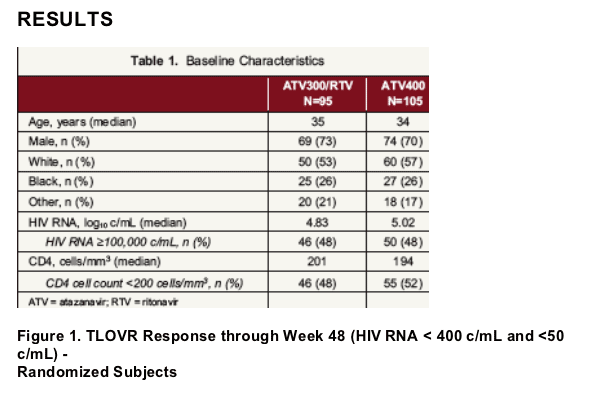
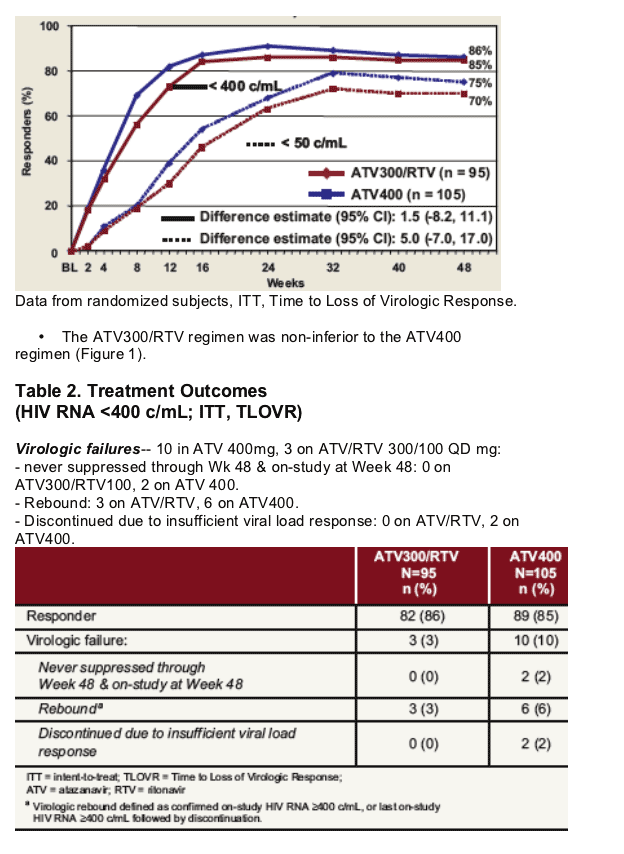
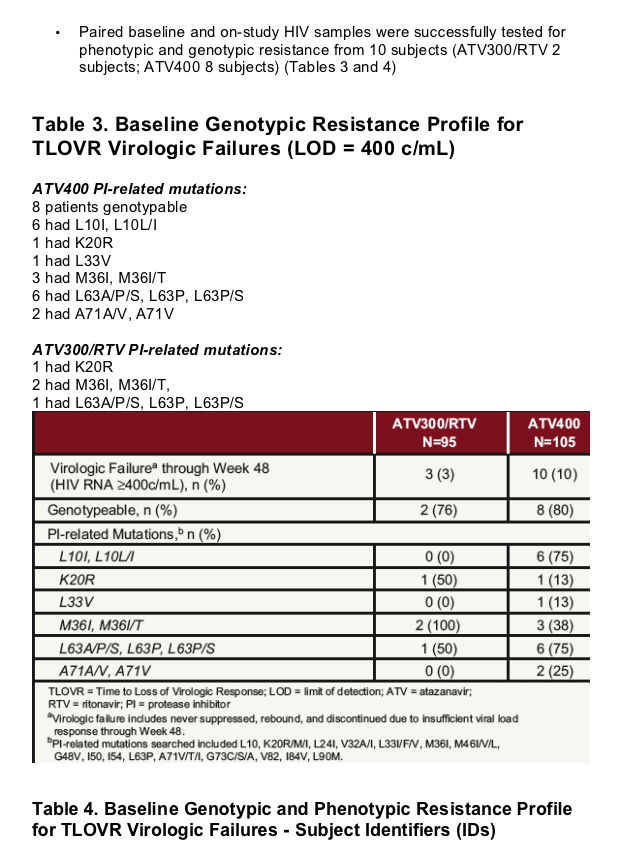

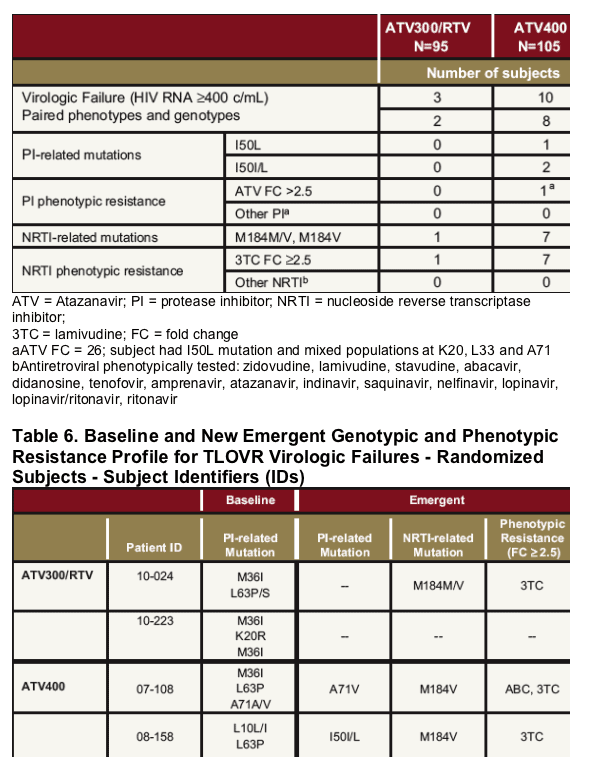
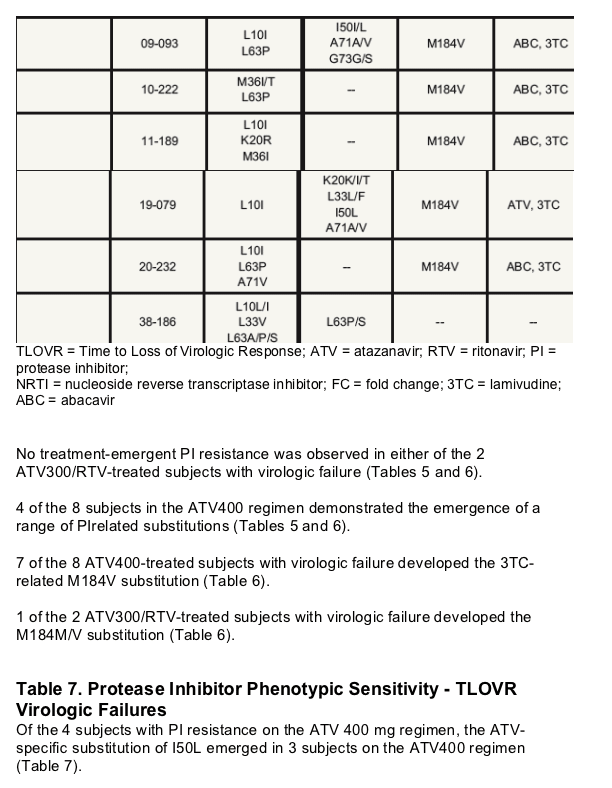
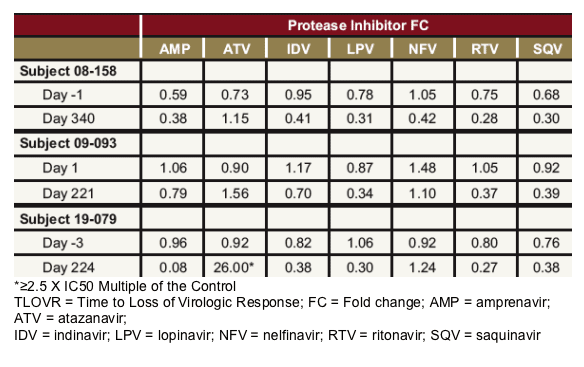
|
| |
|
 |
 |
|
|